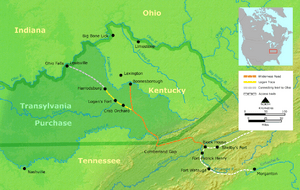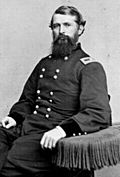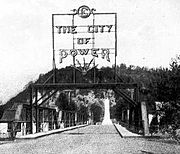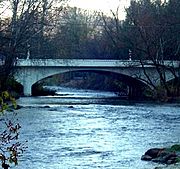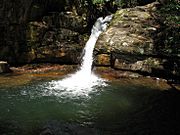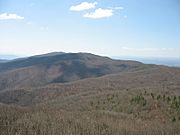Elizabethton, Tennessee facts for kids
Quick facts for kids
Elizabethton
|
|||
|---|---|---|---|
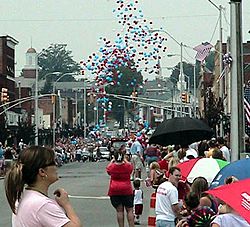
Downtown Elizabethton, July 4 parade (2008)
|
|||
|
|||
| Nickname(s):
The City of Power
|
|||
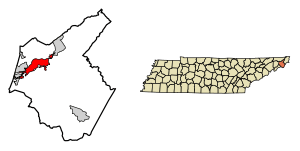
Location of Elizabethton in Carter County, Tennessee.
|
|||
| Country | |||
| State | |||
| County | Carter | ||
| Explored | 1759 | ||
| Settled | 1769 | ||
| Founded | 1799 | ||
| Incorporated: | May 13, 1905 | ||
| Named for | Elizabeth MacLin Carter | ||
| Government | |||
| • Type | Council Manager | ||
| Area | |||
| • Total | 9.70 sq mi (25.11 km2) | ||
| • Land | 9.55 sq mi (24.74 km2) | ||
| • Water | 0.15 sq mi (0.38 km2) | ||
| Elevation | 1,593 ft (465 m) | ||
| Population
(2020)
|
|||
| • Total | 14,546 | ||
| • Density | 1,522.98/sq mi (588.02/km2) | ||
| Time zone | UTC−5 (EST) | ||
| • Summer (DST) | UTC−4 (EDT) | ||
| ZIP codes |
37643-37644
|
||
| Area code(s) | 423 | ||
| FIPS code | 47-23500 | ||
| GNIS feature ID | 1328127 | ||
Elizabethton (/əˈlɪzəbɛθtən/) is a city in Carter County, Tennessee, United States. It is also the county seat, which means it's where the county government is located. Elizabethton is famous for being the site of the first independent American government west of the original Thirteen Colonies. This government was called the Watauga Association and was formed in 1772.
The city also played a big part in the American Revolutionary War. Important events like the Transylvania Purchase (1775) happened here. It was also a key meeting spot for soldiers before battles like the Battle of Musgrove Mill (1780) and the Battle of Kings Mountain (1780). For a few years (1784–1788), Elizabethton was part of the "State of Franklin" territory, which tried to become its own state.
In 2020, about 14,546 people lived in Elizabethton.
Contents
- History of Elizabethton
- Geography of Elizabethton
- People in Elizabethton
- Education in Elizabethton
- Fun Things to Do in Elizabethton
- The Tweetsie Trail
- Sports in Elizabethton
- Famous People from Elizabethton
- See also
History of Elizabethton
Early Native American Life
The land that is now Tennessee was first home to people called Paleo-Indians about 11,000 years ago. Later, different groups lived here, including the Muscogee (also known as Creek) and Yuchi people. Over time, the Cherokee tribe moved south from what is now Virginia and settled in this area.
When Spanish explorers, led by Hernando de Soto, arrived in the 1500s, they found these tribes. Sadly, European diseases caused many Native Americans to die. As more European-American settlers moved in, they often had conflicts with the Native Americans.
Eventually, the U.S. government passed the Indian Removal Act in 1830. This law forced many Native American tribes, including the Cherokee, to leave their homes. From 1838 to 1839, about 17,000 Cherokee people were forced to walk a long, difficult journey to new lands west of Arkansas. This sad event is known as the Trail of Tears, and about 4,000 Cherokees died during the journey.
First European Settlements
In 1769, a young explorer named James Robertson came to this area with Daniel Boone. They found fertile land along the Watauga River valley, which they called "Watauga Old Fields." Robertson planted corn there.
Many people from North Carolina moved to this area after a conflict in 1771. In 1772, Robertson and other pioneers in Northeast Tennessee decided to create their own government. They met at Sycamore Shoals and formed the Watauga Association. This was the first independent American government west of the Appalachian Mountains.
John Sevier, who would later become Tennessee's first governor, also visited the area around this time. In 1772, surveyors found that the land officially belonged to the Cherokee tribe. The settlers had to negotiate a lease with the Cherokee. A Cherokee warrior was sadly killed during the celebration of this agreement, but James Robertson's good diplomacy helped keep the peace.
Before Tennessee became a state, all of its land was part of Washington County, North Carolina. This county was named after George Washington, the leader of the American forces in the Revolution.
Elizabethton and the Revolutionary War
The Transylvania Purchase
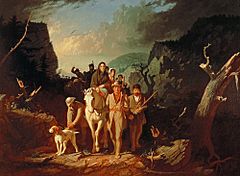
Elizabethton, specifically at Sycamore Shoals, was the site of the Transylvania Purchase. In March 1775, a land investor named Richard Henderson met with over 1,200 Cherokees. Important Cherokee leaders like Attacullaculla and Oconostota were there.
In the Treaty of Sycamore Shoals, Henderson bought a huge amount of land—about 20 million acres (81,000 square kilometers). This land covered half of what is now Kentucky. However, this purchase broke laws in North Carolina, Virginia, and the Royal Proclamation of 1763, which said private citizens couldn't buy Native American land.
Before the treaty, Henderson hired Daniel Boone to tell the Cherokee about the meeting. After the purchase, Boone was hired again to create the Wilderness Road. This path went through the Cumberland Gap and into central Kentucky, leading to new settlements like Boonesborough.
Attacks by Dragging Canoe
During the early part of the American Revolutionary War, Fort Watauga at Sycamore Shoals was attacked in 1776. The attack was led by Dragging Canoe, a Cherokee leader who was against the Transylvania Purchase. Colonels John Sevier and James Robertson were among the brave defenders of the fort.
Settling Middle Tennessee
In 1779, James Robertson and a small group of Watauga settlers traveled west. They chose a spot along the Cumberland River, which is now Nashville. Later that year, Robertson returned with more settlers. They built temporary shelters, and on Christmas Day, their friends and families arrived. They built a fort called Fort Nashborough, named after Francis Nash, a soldier who fought with Robertson.
Overmountain Men and Kings Mountain
Fort Watauga was a key gathering place for soldiers during the Revolutionary War. On September 26, 1780, about 1,100 brave soldiers known as the Overmountain Men met here. They were preparing for a long march over the Blue Ridge Mountains to fight the British Army.
These soldiers marched to the Battle of Kings Mountain in South Carolina. They defeated the British Loyalist forces there, which was a very important victory for the Americans. Before their march, a woman named Mary Patton and her husband made 500 pounds of gunpowder for the soldiers at their mill in Gap Creek. They stored this gunpowder in a dry cave called Shelving Rock.
The Carter Family and Their Mansion
Landon Carter was the son of John Carter, an early settler in Carter County. John Carter's home, built around 1780, is known as the Carter Mansion. It's the oldest wooden frame house in Tennessee and is now a tourist attraction. It's part of Sycamore Shoals State Park. The mansion is located on Broad Street Extension, near the Watauga River.
Elizabethton During the Civil War
During the American Civil War, U.S. President Abraham Lincoln asked Samuel Powhattan (S.P.) Carter, a U.S. naval officer, to help the Union cause. Carter was promoted to a high rank and sent to East Tennessee. His job was to attack Confederate railroad lines and bridges.
Carter's younger brother, William B. Carter, planned the "East Tennessee bridge burnings" in 1861. On November 8, pro-Union people destroyed five railroad bridges in Confederate-held East Tennessee. This caused the Confederate authorities to put much of East Tennessee under martial law, which is when the military takes control.
Samuel P. Carter continued to lead important military operations throughout the war. He was promoted several times for his bravery. A historical marker in downtown Elizabethton honors his life and naval career.
The Veterans' Monument in downtown Elizabethton was built in 1912. It honors all the soldiers from Carter County, from the American Revolution to the Civil War. It's a tall stone monument with two Civil War cannons.
Railroads and Industry
In the early 1900s, Elizabethton became a busy place for trains. Three different railroad companies served the city. One famous narrow-gauge train, called the "Tweetsie," ran from Johnson City through Elizabethton and into North Carolina.
In 1927, part of the railroad was changed to a wider track to help two large rayon factories. These factories, Bemberg and North American Rayon Corporation, were built by German and Dutch investors. They made rayon material for clothes and other products.
During World War II, the U.S. government took control of these factories because they were so important. In 1949, over 6,100 people worked at the rayon mills. Later, a special fiber for the Space Shuttle program was made here. However, due to changes in the market and a fire, the last rayon mill closed in the late 1990s.
"The City of Power"
Elizabethton got its nickname, "The City of Power," because it started getting cheap electricity from hydroelectric power in the early 1910s. The first hydroelectric dam in Tennessee was built on the Watauga River, near Elizabethton, and started producing power in 1912.
In 1928, President Herbert Hoover visited Elizabethton. He gave a speech to 50,000 people, talking about the government's role in producing electricity. Later, in 1933, the Tennessee Valley Authority (TVA) was created. The TVA built more dams, including the Watauga Dam and Reservoir in 1948, which also produces electricity for the area.
Overmountain Victory Trail
In 1975, three Boy Scouts from Elizabethton hiked the entire Overmountain Victory National Historic Trail. This trail is about 214 miles (344 kilometers) long and follows the path the Overmountain Men took to the Battle of King's Mountain during the Revolutionary War.
Liberty: The Saga of Sycamore Shoals is an outdoor play performed in Elizabethton every July. It tells the story of the early history of Northeast Tennessee, using local actors and reenactors.
In 1980, U.S. President Jimmy Carter signed a law making the Overmountain Victory route a National Historic Trail. It was the first such trail in the eastern United States.
Elizabethton Airport Incident
On June 4, 2023, a plane that took off from the Elizabethton airport crashed in Virginia. The pilot lost consciousness, and the plane flew into restricted airspace over Washington, D.C. All four people on board were killed.
Geography of Elizabethton
Location in Northeast Tennessee
Elizabethton is part of the "Tri-Cities" area in Northeast Tennessee, which also includes Bristol, Johnson City, and Kingsport.
The city is located in the Eastern Time zone.
Elizabethton covers about 9.7 square miles (25.1 square kilometers). Most of this is land, with a small amount of water. The Elizabethton Municipal Airport is about 1,593 feet (465 meters) above sea level. The highest point in Carter County is Roan Mountain, which is 6,285 feet (1,916 meters) high.
Lynn Mountain, which is 2,060 feet (628 meters) high, is right across from downtown Elizabethton. The city is bordered by Johnson City to the west.
Water Resources
Spring Water
Elizabethton has a special water supply. In 2010, the city used over 5 million gallons of clean spring water every day from three springs it owns. This is more spring water than any other local water system in Tennessee uses!
The Doe River
The Doe River starts in Carter County, Tennessee, near the North Carolina border. It flows north, then west, and then north again through different communities. The river gets bigger when water from McCathern Spring joins it.
Further downstream, the Doe River flows through Elizabethton. It goes under the historic Elizabethton Covered Bridge, which was built in 1882. This wooden covered bridge is in downtown Elizabethton and connects 3rd Street and Hattie Avenue. It's now closed to cars but is still open for bikes and people walking.
Much of downtown Elizabethton is listed on the National Register of Historic Places because of its history and beautiful buildings. The covered bridge is a very important landmark. There are also two concrete arch bridges over the Doe River in downtown, including the Broad Street Bridge.
Every June, Elizabethton celebrates with the Elizabethton Covered Bridge Days. This event features music, activities for kids, a car show, and many food and craft vendors.
The Watauga River

The Watauga River flows past Elizabethton. Two Tennessee Valley Authority (TVA) dams, the Watauga Dam and the Wilbur Dam, are located upstream on the Watauga River. The Appalachian Trail also crosses the Watauga River near Elizabethton.
The Watauga River flows west past Elizabethton. The downtown area is very close to where the Doe River joins the Watauga River. As mentioned before, Elizabethton was called "The City of Power" because of the hydroelectric power from the Wilbur Dam, which started producing electricity in 1912.
The Bee Cliff Rapids on the Watauga River are a popular spot for whitewater rafters in the summer. Downstream from Elizabethton, the Watauga River has one of only two special "trophy trout streams" in Tennessee, which means it's a great place for fishing.
Holston Mountain Towers
Elizabethton is in a valley surrounded by mountains and hills. Holston Mountain is to the northeast. This mountain is a great place for radio and television signals because it's the highest point facing many cities in Northeast Tennessee.
Many TV and radio stations have their antennas on Holston Mountain. For example, WCYB-TV, WJHL-TV, and WKPT-TV all broadcast from here. Several FM radio stations also have their antennas on the mountain. Different government agencies and utility companies also use the mountain for their communication.
The Federal Aviation Administration has a special navigation beacon on the top of Holston Mountain.
Climate in Elizabethton
| Climate data for Elizabethton, Tennessee (1991–2020 normals, extremes 1895–present) | |||||||||||||
|---|---|---|---|---|---|---|---|---|---|---|---|---|---|
| Month | Jan | Feb | Mar | Apr | May | Jun | Jul | Aug | Sep | Oct | Nov | Dec | Year |
| Record high °F (°C) | 78 (26) |
82 (28) |
84 (29) |
93 (34) |
97 (36) |
102 (39) |
105 (41) |
99 (37) |
98 (37) |
92 (33) |
87 (31) |
80 (27) |
105 (41) |
| Mean daily maximum °F (°C) | 46.2 (7.9) |
50.4 (10.2) |
58.9 (14.9) |
69.0 (20.6) |
76.6 (24.8) |
82.9 (28.3) |
85.5 (29.7) |
85.0 (29.4) |
80.1 (26.7) |
70.0 (21.1) |
58.5 (14.7) |
49.5 (9.7) |
67.7 (19.8) |
| Daily mean °F (°C) | 35.9 (2.2) |
39.2 (4.0) |
46.6 (8.1) |
55.5 (13.1) |
64.2 (17.9) |
71.2 (21.8) |
74.5 (23.6) |
73.7 (23.2) |
67.9 (19.9) |
57.0 (13.9) |
45.9 (7.7) |
39.2 (4.0) |
55.9 (13.3) |
| Mean daily minimum °F (°C) | 25.5 (−3.6) |
28.1 (−2.2) |
34.2 (1.2) |
41.9 (5.5) |
51.8 (11.0) |
59.6 (15.3) |
63.5 (17.5) |
62.3 (16.8) |
55.6 (13.1) |
44.0 (6.7) |
33.3 (0.7) |
28.8 (−1.8) |
44.1 (6.7) |
| Record low °F (°C) | −21 (−29) |
−17 (−27) |
−2 (−19) |
20 (−7) |
28 (−2) |
39 (4) |
46 (8) |
43 (6) |
31 (−1) |
22 (−6) |
10 (−12) |
−12 (−24) |
−21 (−29) |
| Average precipitation inches (mm) | 3.78 (96) |
3.76 (96) |
3.97 (101) |
3.81 (97) |
4.43 (113) |
5.16 (131) |
5.86 (149) |
4.20 (107) |
3.00 (76) |
2.80 (71) |
3.36 (85) |
3.90 (99) |
48.03 (1,220) |
| Average snowfall inches (cm) | 1.9 (4.8) |
2.1 (5.3) |
0.1 (0.25) |
0.0 (0.0) |
0.0 (0.0) |
0.0 (0.0) |
0.0 (0.0) |
0.0 (0.0) |
0.0 (0.0) |
0.0 (0.0) |
0.1 (0.25) |
1.8 (4.6) |
6.0 (15) |
| Average precipitation days (≥ 0.01 in) | 12.5 | 12.2 | 13.1 | 11.9 | 12.7 | 13.4 | 13.5 | 11.6 | 9.0 | 8.9 | 10.2 | 12.8 | 141.8 |
| Average snowy days (≥ 0.1 in) | 1.2 | 1.2 | 0.4 | 0.0 | 0.0 | 0.0 | 0.0 | 0.0 | 0.0 | 0.0 | 0.3 | 1.2 | 4.3 |
| Source: NOAA | |||||||||||||
Getting to Elizabethton
The closest major highway is I-26 in Johnson City. To get to Elizabethton, you take Exit 24 and drive east for about 8 miles (13 kilometers) on U.S. Route 321 and Tennessee State Route 67.
People in Elizabethton
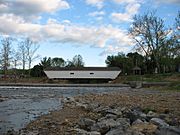
| Historical population | |||
|---|---|---|---|
| Census | Pop. | %± | |
| 1850 | 373 | — | |
| 1860 | 360 | −3.5% | |
| 1870 | 321 | −10.8% | |
| 1880 | 362 | 12.8% | |
| 1890 | 734 | 102.8% | |
| 1910 | 2,478 | — | |
| 1920 | 2,749 | 10.9% | |
| 1930 | 8,093 | 194.4% | |
| 1940 | 8,516 | 5.2% | |
| 1950 | 10,754 | 26.3% | |
| 1960 | 10,896 | 1.3% | |
| 1970 | 12,269 | 12.6% | |
| 1980 | 12,431 | 1.3% | |
| 1990 | 11,931 | −4.0% | |
| 2000 | 13,372 | 12.1% | |
| 2010 | 14,176 | 6.0% | |
| 2020 | 14,546 | 2.6% | |
| Sources: | |||
Population in 2020
| Race | Number | Percentage |
|---|---|---|
| White (non-Hispanic) | 13,029 | 89.57% |
| Black or African American (non-Hispanic) | 355 | 2.44% |
| Native American | 36 | 0.25% |
| Asian | 98 | 0.67% |
| Pacific Islander | 2 | 0.01% |
| Other/Mixed | 634 | 4.36% |
| Hispanic or Latino | 392 | 2.69% |
In 2020, Elizabethton had 14,546 people living in the city. There were 5,448 households and 3,301 families.
Education in Elizabethton
Colleges and Universities
You can find satellite campuses of Northeast State Community College and Tennessee College of Applied Technology in the eastern part of Elizabethton.
Milligan University and Emmanuel Christian Seminary are located in the southwestern part of the city.
Schools for Kids
Elizabethton City Schools manages the public schools in the city:
- Elizabethton High School
- T.A. Dugger Jr. High School
- East Side Elementary School
- Harold McCormick Elementary School
- West Side Elementary School
Fun Things to Do in Elizabethton
Sycamore Shoals State Historic Area is a great place to visit in Elizabethton. It has three different parts: the main area, Sabine Hill, and the Carter Mansion.
The City of Elizabethton Parks and Recreation Department takes care of many parks and recreational areas:
- Harmon Park – 1.9 acres
- Cat Island Park – 12.5 acres
- Covered Bridge Park – 2.25 acres
- Edward's Island Park – 3.2 acres
- Walter Curtis Memorial Park – 1.6 acres
- Douglas Park – 3.7 acres
- Carmen Dugger Sports Complex – 9.8 acres
- Kiwanis Park – 3.1 acres
- Riverside Park – 6.8 acres
- Lions Field – 12 acres
- Race Street Park – 1.3 acres
- Mill Race Park – 0.5 acres
- Dixon Street Park – 1.4 acres
- Elizabethton Linear Path (Greenway) – 6 miles long
The Tweetsie Trail
The Tweetsie Trail is a special path built on old railroad tracks. It connects Johnson City and Elizabethton and is perfect for walking, hiking, running, biking, and eBiking. The path is mostly flat and goes through natural areas.
The first part of the trail, from Johnson City to Sycamore Shoals State Park, opened in 2014. The second part, which goes into downtown Elizabethton, opened in 2015. The entire trail is now 10 miles (16 kilometers) long. There are plans to make the trail even longer, extending it towards Roan Mountain, Tennessee.
Sports in Elizabethton
Elizabethton has been home to several Minor League Baseball teams. The first team was the Elizabethton Betsy Red Sox, who played in the Appalachian League starting in 1937. They won championships in 1939 and 1941.
Later teams included the Elizabethton Betsy Cubs and the Elizabethton Phils. From 1974 to 2020, the city had the Elizabethton Twins. They won the league championship 12 times, which is more than any other team in the league's history!
Starting in 2021, the Appalachian League changed to a collegiate summer baseball league. The Twins were replaced by a new team called the Elizabethton River Riders. This league is for college baseball players.
Famous People from Elizabethton
Many notable people have connections to Elizabethton:
- Paul Edward Anderson – An Olympic gold medalist in weightlifting.
- Margaret Bowen – She led a famous walkout of female workers in 1929, starting important labor strikes.
- William Gannaway Brownlow – A former governor of Tennessee, U.S. senator, and newspaper publisher.
- Evan Carter – A Major League Baseball outfielder who won the 2023 World Series with the Texas Rangers.
- Samuel P. Carter – A unique individual who was both a U.S. Army general and a U.S. Navy admiral.
- Charles Davis – A former University of Tennessee football player and now a sports analyst.
- Landon Carter Haynes – A Speaker of the Tennessee House of Representatives and a Confederate senator.
- Alec McLean – An Olympic rower.
- Thomas Amos Rogers Nelson – An early Elizabethton lawyer and member of the U.S. House of Representatives.
- Dayton E. Phillips – A judge and member of the U.S. House of Representatives.
- Jeff Reed – A Major League Baseball catcher.
- Alfred A. Taylor – A former governor of Tennessee and congressman.
- Robert Love Taylor – Also a former governor of Tennessee and a U.S. senator.
- Kent Williams – A Speaker of the Tennessee House of Representatives.
- Jason Witten – A famous National Football League tight end.
See also
 In Spanish: Elizabethton para niños
In Spanish: Elizabethton para niños






